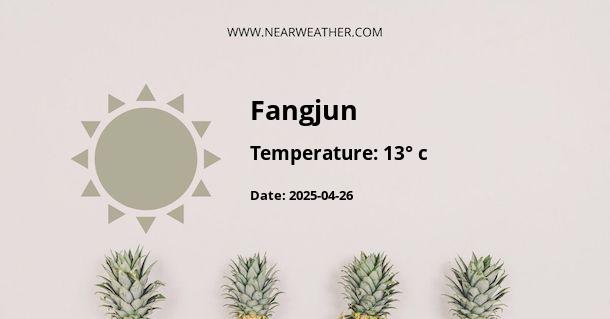Climate and Weather in Fangjun, CN
Fangjun is a town located in the northern part of China, specifically in the Shanxi province. It is known for its unique climate and weather patterns throughout the year. Understanding the climate in Fangjun is important for residents and visitors alike, as it can greatly impact daily activities, agriculture, and overall quality of life. In this article, we will delve into the details of Fangjun's climate and weather, providing you with accurate and up-to-date information.
Geographical Factors
Fangjun is situated in a region that experiences a continental climate. The town is surrounded by mountains, which have a significant impact on the local weather patterns. The Taihang Mountains to the east and the Lüliang Mountains to the west create a natural barrier that affects temperature and precipitation in Fangjun.
Temperature
The temperature in Fangjun can vary greatly throughout the year. Summers are hot, with temperatures often exceeding 30°C (86°F). The peak of summer, which falls in July, is the hottest month in Fangjun. However, the surrounding mountains provide some relief, as they help to moderate the temperatures slightly.
Winters in Fangjun are cold and harsh. January is the coldest month, with temperatures often dropping below freezing. It is not uncommon for temperatures to reach as low as -10°C (14°F) during the winter months. Residents and visitors should be prepared for cold temperatures and ensure they have appropriate clothing to stay warm.
Precipitation
Fangjun experiences a moderate amount of precipitation throughout the year, with the majority falling during the summer months. The town receives an average of 500-600 millimeters of rainfall annually. The wettest months are from June to September, with July and August being the peak months for rainfall. During this time, it is common to experience heavy showers and thunderstorms.
Winter months, on the other hand, tend to be drier, with less rainfall and occasional snowfall. The average snowfall in Fangjun is around 20-30 centimeters per year. Snowfall is more prevalent in the higher elevations of the surrounding mountains, creating a picturesque winter landscape.
Wind Patterns
Due to its geographical location and the presence of mountains, Fangjun experiences varying wind patterns throughout the year. During the summer, warm and moist air masses from the southeast prevail, bringing in humid conditions and occasional gusty winds. These winds help to alleviate some of the heat during the hottest months.
In contrast, the winter season sees the influence of cold and dry air masses from the northwest. These winds can be quite strong, especially in the mountainous areas surrounding Fangjun. It is important to take precautions and dress appropriately to protect against the chill and wind chill factor.
Seasonal Variations
The four seasons in Fangjun are distinct, each offering its own unique climate and weather characteristics.
Spring: Spring in Fangjun is mild and pleasant, with temperatures gradually rising from around 10°C (50°F) in March to 20°C (68°F) in May. It is a relatively dry season, with sporadic rainfall.
Summer: Summers in Fangjun are hot and humid, with temperatures averaging around 30°C (86°F). July and August are the hottest and wettest months, with occasional thunderstorms.
Autumn: Autumn brings cooler temperatures, ranging from 15°C (59°F) in September to 5°C (41°F) in November. The weather is generally dry and mild, making it a pleasant season to explore the surrounding natural beauty.
Winter: Winter in Fangjun is cold, with temperatures dropping below freezing. January is the coldest month, and snowfall is not uncommon. It is important to bundle up and take precautions to stay warm during this season.
Impacts on Agriculture
The climate and weather patterns in Fangjun play a crucial role in agriculture, which is a significant industry in the region. The moderate amount of rainfall and the presence of mountains contribute to fertile soil, making Fangjun suitable for various crops, including wheat, corn, and beans.
However, the seasonal variations in temperature and precipitation can also pose challenges for farmers. Extreme heat and drought in the summer months can impact crop growth, while freezing temperatures in winter can damage crops that are not properly protected. Farmers in Fangjun employ various techniques, such as irrigation and greenhouse cultivation, to mitigate the effects of the climate on their agricultural activities.
Conclusion
Fangjun, CN, experiences a continental climate with distinct seasonal variations. Summers are hot and humid, while winters are cold and dry. The surrounding mountains influence the temperature and precipitation patterns in the town. Understanding the climate in Fangjun is important for residents and visitors to plan their activities and make necessary preparations. Whether you are exploring the natural beauty of Fangjun or engaging in agricultural practices, being aware of the climate and weather conditions will enhance your experience in this unique location.
A - Fangjun's Latitude is 29.071390 & Longitude is 120.245003.
A - Weather in Fangjun is 13° today.
A - Climate Conditions in Fangjun shows overcast clouds today.
A - Humidity in Fangjun is 94% today.
A - Wind speed in Fangjun is 5 km/h, flowing at 93° wind direction. today.
